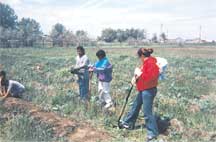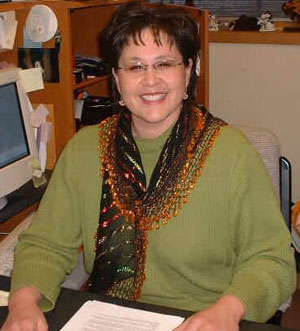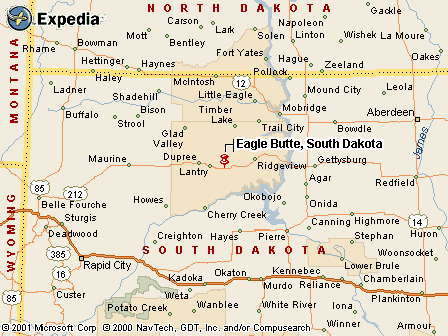 EAGLE
BUTTE - A sprawling garden of pumpkins, corn and green beans
near the Billy Mills Youth Center in Eagle Butte is a tangible
symbol of a far grander dream being planted on the Cheyenne
River Indian Reservation. EAGLE
BUTTE - A sprawling garden of pumpkins, corn and green beans
near the Billy Mills Youth Center in Eagle Butte is a tangible
symbol of a far grander dream being planted on the Cheyenne
River Indian Reservation.
Weeding,
watering and nurturing the two-acre garden gives young reservation
children a sense of their connection to the land, said Julie
Garreau, director of the youth center. And a planned teen
center addition to the Billy Mills facility will provide a
connection between the center's established programs for pre-teens
and the changing demands of soon-to-be adults, she said.
For
15 years, Garreau has been director of the Eagle Butte youth
center - formerly called "The Main" because of the
building that housed it on the community's main street. For
all of that time, Garreau has pushed to expand the programs,
to reach more children at more stages of development and to
give them positive outlets for their energies and their dreams.
 "One
way or another, the Main has always been about planting seeds,"
Garreau said Monday in an interview in her small office in
the youth center on the southeast edge of Eagle Butte. "In
the garden, there is an actual planting of seeds. But in the
programs, and in the teen center we're about to begin building,
there's a more symbolic planting of seeds, hoping for the
same kind of growth. "One
way or another, the Main has always been about planting seeds,"
Garreau said Monday in an interview in her small office in
the youth center on the southeast edge of Eagle Butte. "In
the garden, there is an actual planting of seeds. But in the
programs, and in the teen center we're about to begin building,
there's a more symbolic planting of seeds, hoping for the
same kind of growth.
"Yes,
the garden produces vegetables and fruit that nourish us,
but the youth programs, and someday soon the teen center,
also can be nourishing in their own ways."
Garreau
knows a thing or two about planting seeds and watching them
grow.
She
headed a group that took an old building in downtown Eagle
Butte and converted it to a youth center for kids up to age
12. The place worked well enough, but Garreau dreamed of a
bigger building, a center that could hold a kitchen, room
for volunteers, a modest library, play yard and activities
room. A Virginia-based charitable group and a Lakota track
superstar helped bring that about.
Running
Strong for American Indian Youth helped provide grant money
and support for the youth center. Billy Mills, an Oglala who
shocked the international track audience with a hard-charging
finish to win the 10,000-meter run in the 1964 Olympics, became
the group's national spokesman and lent his name to the youth
center. A community food pantry followed and, three years
ago, so did a revitalized food plot tended and managed by
children.
The
garden is a simple sign of what Running Strong is all about,
said Molly Farrell, who handled public awareness activities
for the organization.
"Running
Strong tries to do the basic things, starting slowly and with
a small step, as we did with the Cheyenne River Youth Project,
and letting it build," Farrell said. "We try to
take into account what the people need, not what we think
they need or should have. A youth garden is a basic need for
nutrition and activity."
It's
an exciting place to be on a summer afternoon, Shalynn Carter
said. The 9-year-old is in her first summer as a gardener.
"I
just like working in the earth," she said. "It's
fun to watch the seeds turn into something real."
Carter,
the most recent Gardener of the Week, said watering the long,
low beds of vegetables and fruit is preferable to pulling
the weeds that spring up between the rows. It gives her a
good feeling to see the vegetables grown in the youth garden
end up in meals at the center or as donations to the elders
of the community.
"Yeah,
that's one of the good things," she said.
Harmony
with land
A
smaller version of the current garden had existed for some
time, but it was neglected and run- down, Garreau said. Two
years ago, the youth project decided to make it a place where
children could watch things grow and, in the process, learn
valuable lessons about the relationship between people and
the land.
A
$4,000 grant from Running Strong helped get the two-acre tract
started, but Garreau said it also took community volunteers,
donated equipment and help from the local college to make
it real. The children take turns on garden duty, and each
week one or more of the youngsters is designated - as Shalynn
Carter was this week- as Gardener of the Week, an honor that
includes a T-shirt and a photo in the weekly newspaper. Carter
said she's excited about having her photo in the newspaper.
Although
Garreau is an optimist, she admits the success of the garden
caught her off guard.
"I
was a little amazed when things actually grew," Garreau
said. "First thing you knew, we had more vegetables than
we knew what to do with. We had this incredible harvest of
eggplant. We canned a lot of stuff, made salsa, even jalapeno
jelly. Every day, they'd be going past with a wheelbarrow
filled with something. Green beans, peas."
Nutritional
benefits
For
a race of people with whom diabetes is almost epidemic, the
value of proper diet can't be overstated, Garreau said.
"We
actually have kids eating broccoli," she said. "We
had to start by covering it with cheese, but we gradually
cut that back."
The
gardening work is the first time many of the children have
been directly involved in seeing something grow, she said.
It teaches them about the care required to nurture a plant,
the need to step lightly around the planted zucchini and peppers
and corn and strawberries. More than that, it gives them a
respect for the land and the environment, especially since
the garden is completely organic, she said.
"It's
an amazing thing when a kid takes a seed and puts it in the
ground and then sees what it becomes," she said. "That
process helps the kids see the balance in the world, and so
much of that has been lost. It's incredibly important, it's
part of our Lakota tradition."
Some
of the harvest goes into the meals at the youth center, where
children have snacks and an evening meal each day. Some goes
to the food pantry. A good portion of the produce is shared
with elders from the community, something that Garreau said
has a much greater effect than simply giving an old person
a piece of squash or tomato.
"That's
an important connection, the young kids and the elders, where
sometimes that bond is broken these days."
Stretching
the program
The
decision to expand to a teen center and accompanying programs
is an attempt to stretch that bond to include the reservation
people between the youth and the elderly, Farrell said.
"It
really doesn't seem fair to tell a child who has been involved
in the youth program that just because he's turned 12, he
can no longer be part of the program," she said. "One
of the biggest concerns about teens on the reservation is
the lack of things to do."
The
teen center is a way to keep the connection with the reservation,
she said.
"It
really does address an immediate need," Farrell said.
"We're committed to being involved in these kinds of
basic projects that can make such a difference."
A
warehouse on the east side of the youth center is structurally
sound and can be the core of the new teen center, Garreau
said. An architect is in the design stage of what is expected
to be a $1.5 million project. Running Strong has offered a
$250,000 challenge grant, the seed, if you will, from which
the rest of the financing will grow as other corporations
and national associations meet the challenge. Garreau hopes
ground can be broken next spring and the teen center in operation
perhaps nine months later.
For
recommendations from furnishings to programs, she turned to
the experts - local teenagers.
"I'd
say, what do you want in this place?" she said.
"It
has to be a cool place, someplace they want to be. They'd
say, oh, we need big, overstuffed couches, and I'd nod and
say, well, we can work with that. I'm really excited about
what this next step will bring."
The
place will include a basketball court, library, art lab, dance
area, video arcade and counselors' offices, she said. Eagle
Butte has more than 600 kids in the junior high and high school,
all potential users of the teen center. And the teens from
other reservations communities will be made to feel welcome
to be part of the program.
Garreau
gets a far-away expression when she talks about perhaps one
day being able to provide transportation to the teen center
for young people from other communities. That, perhaps, is
a seed not quite ready to plant.
"We
need to get this built first," Garreau said. "It
will happen, I promise you."
Some
of the Running Strong for American Indian Youth projects in
South Dakota:
- Cheyenne
River Youth Garden. A $4,000 grant to help start a two-acre
garden.
- Water
wells on the Pine Ridge Indian Reservation. Each year, Running
Strong drills 13 wells for families living without clean
water. In 2002, the wells averaged 148 feet deep and cost
an average of $6,027.
- Cheyenne
River Youth Project. More than $53,000 in grants have helped
the project provide meals, activities and supervision for
an average of 300 kids per month.
- SuAnne
Big Crow Boys and Girls Club. $100,000 for a Pine Ridge
youth center.
- Pine
Ridge Dialysis Clinic. In 2002, Running Strong joined the
Oglala Sioux Tribe, the Indian Health Service and the Diabetes
Action Research and Education Foundation to build a new
dialysis clinic on the reservation.
Source:
Running Strong 2002 annual report
|


 EAGLE
BUTTE - A sprawling garden of pumpkins, corn and green beans
near the Billy Mills Youth Center in Eagle Butte is a tangible
symbol of a far grander dream being planted on the Cheyenne
River Indian Reservation.
EAGLE
BUTTE - A sprawling garden of pumpkins, corn and green beans
near the Billy Mills Youth Center in Eagle Butte is a tangible
symbol of a far grander dream being planted on the Cheyenne
River Indian Reservation.  "One
way or another, the Main has always been about planting seeds,"
Garreau said Monday in an interview in her small office in
the youth center on the southeast edge of Eagle Butte. "In
the garden, there is an actual planting of seeds. But in the
programs, and in the teen center we're about to begin building,
there's a more symbolic planting of seeds, hoping for the
same kind of growth.
"One
way or another, the Main has always been about planting seeds,"
Garreau said Monday in an interview in her small office in
the youth center on the southeast edge of Eagle Butte. "In
the garden, there is an actual planting of seeds. But in the
programs, and in the teen center we're about to begin building,
there's a more symbolic planting of seeds, hoping for the
same kind of growth. 